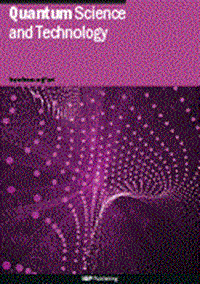Noise-aware entanglement generation protocols for superconducting qubits with impedance-matched FBAR transducers
IF 5
2区 物理与天体物理
Q1 PHYSICS, MULTIDISCIPLINARY
引用次数: 0
Abstract
Connecting superconducting quantum processors to telecommunications-wavelength quantum networks is critically necessary to enable distributed quantum computing, secure communications, and other applications. Optically-mediated entanglement heralding protocols offer a near-term solution that can succeed with imperfect components, including sub-unity efficiency microwave-optical quantum transducers. The viability and performance of these protocols relies heavily on the properties of the transducers used: the conversion efficiency, resonator lifetimes, and added noise in the transducer directly influence the achievable entanglement generation rate and fidelity of an entanglement generation protocol. Here, we use an extended Butterworth–van Dyke (BVD) model to optimize the conversion efficiency and added noise of a Thin film bulk acoustic resonator (FBAR) piezo-optomechanical transducer. We use the outputs from this model to calculate the fidelity of one-photon and two-photon entanglement heralding protocols in a variety of operating regimes. For transducers with matching circuits designed to either minimize the added noise or maximize conversion efficiency, we theoretically estimate that entanglement generation rates of greater than can be achieved at moderate pump powers with fidelities of . This is the first time a BVD equivalent circuit model is used to both optimize the performance of an FBAR transducer and to directly inform the design and implementation of an entanglement generation protocol. These results can be applied in the near term to realize quantum networks of superconducting qubits with realistic experimental parameters.阻抗匹配FBAR换能器超导量子比特的噪声感知纠缠产生协议
将超导量子处理器连接到电信波长量子网络对于实现分布式量子计算、安全通信和其他应用至关重要。光介导的纠缠预警协议提供了一种短期解决方案,可以在不完美的组件上取得成功,包括亚单位效率的微波光量子换能器。这些协议的可行性和性能在很大程度上取决于所使用换能器的特性:转换效率、谐振器寿命和换能器中添加的噪声直接影响可实现的纠缠生成速率和纠缠生成协议的保真度。本文采用扩展的Butterworth-van Dyke (BVD)模型对薄膜体声谐振器(FBAR)压电光机械换能器的转换效率和附加噪声进行了优化。我们使用该模型的输出来计算在各种操作制度下单光子和双光子纠缠预警协议的保真度。对于设计匹配电路以最小化附加噪声或最大化转换效率的换能器,我们理论上估计在中等泵浦功率下,可以实现大于的纠缠产生率,保真度为。这是首次使用BVD等效电路模型来优化FBAR换能器的性能,并直接告知纠缠生成协议的设计和实现。这些结果可以在短期内应用于实现具有真实实验参数的超导量子比特量子网络。
本文章由计算机程序翻译,如有差异,请以英文原文为准。
求助全文
约1分钟内获得全文
求助全文
来源期刊

Quantum Science and Technology
Materials Science-Materials Science (miscellaneous)
CiteScore
11.20
自引率
3.00%
发文量
133
期刊介绍:
Driven by advances in technology and experimental capability, the last decade has seen the emergence of quantum technology: a new praxis for controlling the quantum world. It is now possible to engineer complex, multi-component systems that merge the once distinct fields of quantum optics and condensed matter physics.
Quantum Science and Technology is a new multidisciplinary, electronic-only journal, devoted to publishing research of the highest quality and impact covering theoretical and experimental advances in the fundamental science and application of all quantum-enabled technologies.
 求助内容:
求助内容: 应助结果提醒方式:
应助结果提醒方式:


